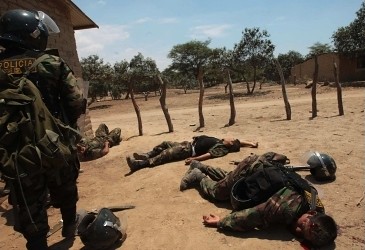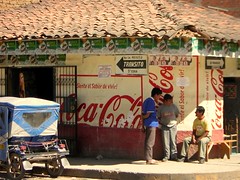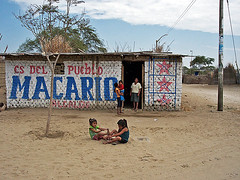The muslim Moors who conquered much of Spain left their mark there – for hundreds of years after the Christian reconquering many Islamic traditions continued to be followed in the south. The Moors impact on Spanish culture is visible in the language, the architecture and typical dress.
In South America these Islamic influences were brought from Spain by Spanish immigrants in the times of the various vice royalties – during Spain’s colonial height.
Category: "Lima City Guide"
Barranco – Slope of the Baths
The history of Barranco is here, but what I neglected to mention was the most important part. It’s not important for what happened there and no Chileans destroyed it. It’s important because it’s the natural feature for which the town was named. This natural feature is a ravine that is cut into the cliff and runs down to the beaches below.
Barranco
Not far from the village of Surco and some way from the city of Lima was the fishing village of Barranco. Time passed and Barranco became a small town popular with Lima’s elite – many of whom decided to build large lavish houses there.
For a while Barranco was named the City of Windmills as each home in the area had a windmill on its property to pump water from wells. More time passed and Barranco became a popular seaside resort coping with an influx of rich Limeños and foreigners building country homes there. Many of the foreigners at this time, around the late 1700’s, were British and German. Still, despite increased development into the 1800’s the town was an calm oasis in the desert, with sufficient supplies of water and trees to be seen everywhere. It was peaceful – but not for long.
Barranco – Iglesia de la Ermita
Barranco, long since swallowed up by the huge city of Lima, was once a tiny distant fishing village. Legend has it that one winter, while out fishing, a group of fishermen were lost in Lima’s legendary sea mist. After praying and searching in vain for hours in the darkness they noticed a glittering light in the distance. Rowing towards it, they ran ashore and were saved. They climbed the cliff to where they had seen the light and found nothing but a wooden cross in the sand.
It was here, as the legend goes, they built the Church of La Ermita, where it still stands to this day.
Huaca Pucllana
In the centre of Miraflores in the city of Lima resides a large mound of dry mud that rises above the surrounding buildings. Close to the rising mountains of the Andes such a thing doesn’t seem entirely out of place – until you look closer. Those are bricks… terraces… stairs. Could it be that this formation is man-made?
Falcon-Condor Air Show
La Costa Verde was the busiest I have ever seen it as the Joint US-Peruvian air show got under way. Between aerobatic displays the USAF “Tailgaters” band played US folk tunes. Like the display yesterday, the aeroplanes were great, but with more cloud cover today…
Falcon-Condor Exhibition
On my last visit to Las Palmas Air Base I watched a rather small version of the 28th July parade that took place the next day, and briefly bumped into Ex-President Toledo who is now in trouble over allegations that he falsified signatures for his party’s formation.
Fighter Jets over Lima
Fighter Jets, notably US F-16s and Peruvian MiG-29s, have be roaring over the city all day for the past 3 days.
It’s all part of the joint USAF-FAP exercises that have been taking place over the past week. Falcon-Condor is designed to build relations and share strategies between the two countries.
San Isidro
I said in the previous post that people find Lima to be dirty. Where a small poor town in the mountains would be described by a tourist as authentic or rustic, the run down parts of Lima don’t get the same kind treatment. Also, for some reason, these tourists apply this to the whole city. Lima is poor, ugly and dirty they say.
La Costa Verde
Annett always complains that my photos concentrate on the ugly parts of Peru or Lima. That may be true because those gritty parts interest me the most and to me are less ugly than to a Peruvian. But it has to be said, some parts of this city for example are very beautiful.
Lima’s Old City Walls
As part of the restoration work of recent years a section of the southern river bank of the Rimac, where the railway to Huancayo runs, was turned into a small park with fountains for people to come and walk through. During this work the forgotten colonial walls of Lima were rediscovered and preserved as an attraction within the small park.
Cerro Azul – Lima’s Beaches
South of the city of Lima are dozens of beaches on an irregular desert coastline that are visited by thousands of Limeños in the summer months. The first set of beaches outside of the city are in the Lurín valley and continue down to the famous beaches at Asia and then towards the edge of the Lima region. Bays, sandy beaches, peninsulas, cliffs, and rocks, the coast spans hundreds of kilometres and has it all.








![Can painting a mountain restore a glacier? [Featured]](http://farm5.static.flickr.com/4005/4709411161_33137b8a6d_m.jpg)

